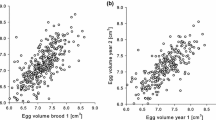Abstract
Breeding ecology of brooding males of the water bugDiplonychus major was investigated in the field and laboratory. During one breeding season an individual male may consecutively brood 3 or 4 egg-masses on his back until hatching. The 1st and the 2nd egg-masses brooded took about 1 month to hatch. Eggs generally hatched. Most of them hatched in synchronously, and males received a new brood of eggs within a few days. Therefore, total male back spaces in the pond, here regarded as the reproductive resource for females, showed considerable fluctuation. When the resource was in low availability, male back space was estimated to be strongly limiting, and in order to ensure successful oviposition in a competitive environment, females are expected to lay eggs aggressively. In laboratory studies, intensive competition to lay eggs was observed, and polygamy also occurred. Males always attempted to copulate before receiving eggs. However, some females sometimes thrust themselves into mating pairs and laid eggs without copulation before the copulating female laid her eggs. Repeated copulation was likely unnecessary for females. Furthermore, since individual male back space is always limiting for each individual male it is evolutionarily advantageous for a male to receive only eggs fertilized by himself. Oviposition occurring without additional copulations, as observed in this study, is new evidence supporting the paternity assurance hypothesis.
Similar content being viewed by others
References
Ichikawa, N. 1985 Observation ofDiplonychus major.Insectarium 22: 224–228. (In Japanese)
Kraus, W. F. 1989 Is male back space limiting? An investigation into the reproductive demography of the giant water bug,Abedus indentatus (Heteroptera: Belostomatidae).J. Insect Behav. 2(5): 623–648.
Lauck, D. R. & A. S. Menke 1961 The higher classification of the Belostomatidae (Hemiptera).Ann. Entomol. Soc. Am. 54: 644–657.
Okada, H. 1987 Breeding ecology ofDiplonychus japonicus Vuillefroy.Graduation thesis of Tokyo Univ. of agriculture and technology. (In Japanese)
Smith R. L. 1979a Paternity assurance and altered roles in the mating behaviour of a giant water bug,Abedus herberti (Heteroptera: Belostomatidae).Anim. Behav. 27(3): 716–725.
Smith, R. L. 1979b. Repeated copulation and sperm precedence: Paternity assurance for a male brooding water bug.Science 205: 1029–1031.
Author information
Authors and Affiliations
About this article
Cite this article
Ichikawa, N. Breeding strategy of the male brooding water bug,Diplonychus major esaki (Heteroptera: Belostomatidae): Is male back space limiting?. J. Ethol. 7, 133–140 (1989). https://doi.org/10.1007/BF02350035
Received:
Accepted:
Issue Date:
DOI: https://doi.org/10.1007/BF02350035




